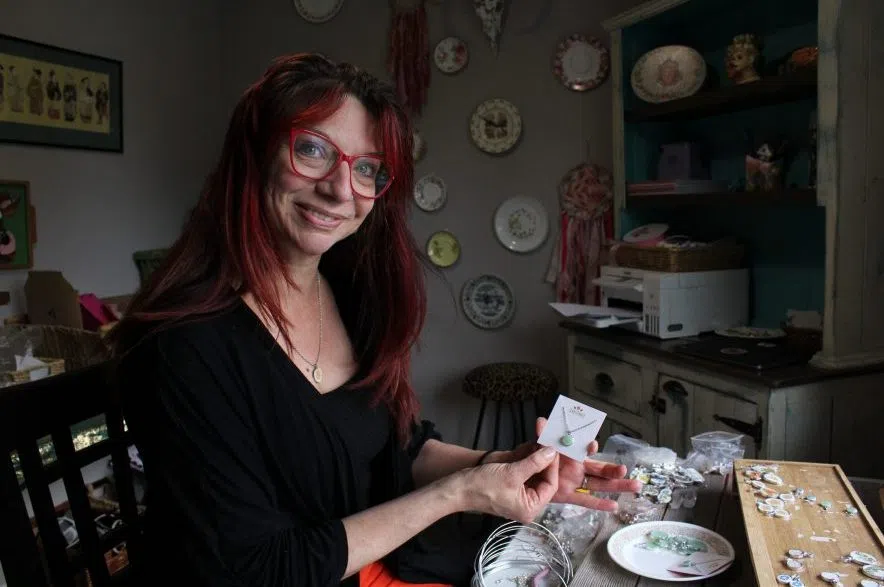In the quiet heart of Saskatoon, in a cozy home nestled among tree-lined streets, there is a basement known as “the pit.”
It’s not a glamorous place — walking through it requires sturdy shoes thanks to the countless fragments of shattered dishes that litter the floor — but to Sheri Wollf, this is sacred ground.
It’s where transformations begin.

Amid the chaos of shattered china and tools, a transformation begins. What some may see as a mess has the makings of something meaningful. (Brittany Caffet/650 CKOM)
Listen to Sheri Wollf on Behind the Headlines:
“I say it’s marital therapy,” Wollf laughed in an interview with 650 CKOM. “When I’m upset with my husband, I can just go down to the pit and smash some dishes. But really it’s a little bit more refined than that.”
Breaking dishes is just part of the process of Wollf’s small business, Transformed Jewelry. Over the past decade, she has turned thousands of pieces of broken, forgotten china into wearable treasures.
Read More:
- Guitar-making school in rural Sask. attracts students worldwide
- Large and in charge: What it takes to eat like the Riders’ O-line
- Vintage quilts, modern coats: A Saskatchewan crafter’s cozy transformations
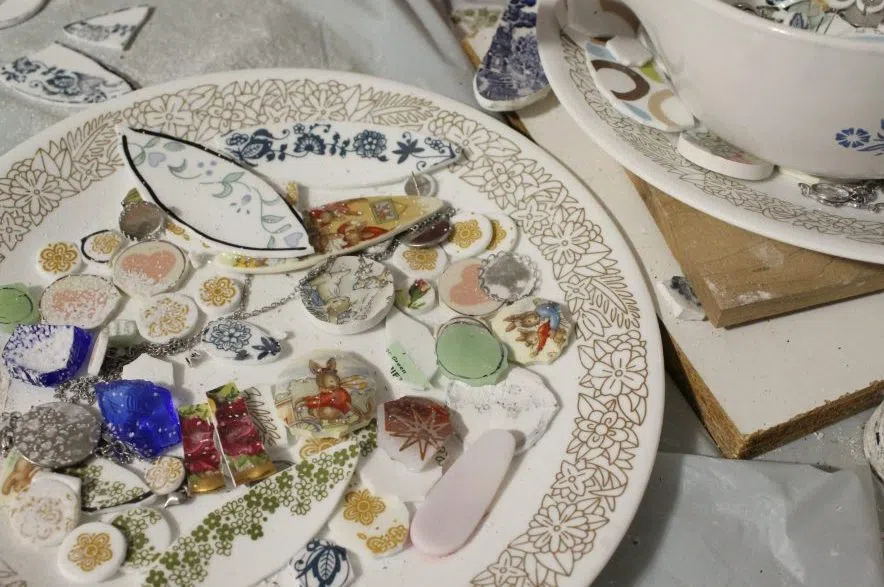
Each piece begins with careful cutting and sanding — a hands-on process Sheri Wollf has perfected over the last decade. (Brittany Caffet/650 CKOM)
“I have a wonderful, creative process of recycling dishes,” she explained. “There’s not really a lot of ways to reuse, recycle or repurpose them, and we’ve got a lot of them out in the world. So I take them and I make them into beautiful little things that you can wear close to your heart.”
From dusty shelves to precious keepsakes
The idea was born 10 years ago when Wollf was helping her father set up an antique store. As they scoured garage sales and flea markets, she found herself drawn to stacks of beautiful, unloved china.
“I saw all of these beautiful dishes, but nobody wanted them,” she recalled. “And I thought, ‘You know what? I’m going to make people love these dishes again.’”

Wollf searches for patterns that stir hearts — from fine, bone china to everyday plates served at church suppers. (Brittany Caffet/650 CKOM)
It took her more than a year to develop her own unique process, and it’s one she still uses today. Down in “the pit,” she cuts each piece of dishware using nippers, cutters, saws — whatever tool the job demands. The edges are then ground smooth.
Once the raw pieces are shaped, Wollf carries them upstairs to her tiny home studio. There, the transformation is completed: settings are chosen, metal is wrapped, glue is applied. From start to finish, creating one piece takes her about four hours.
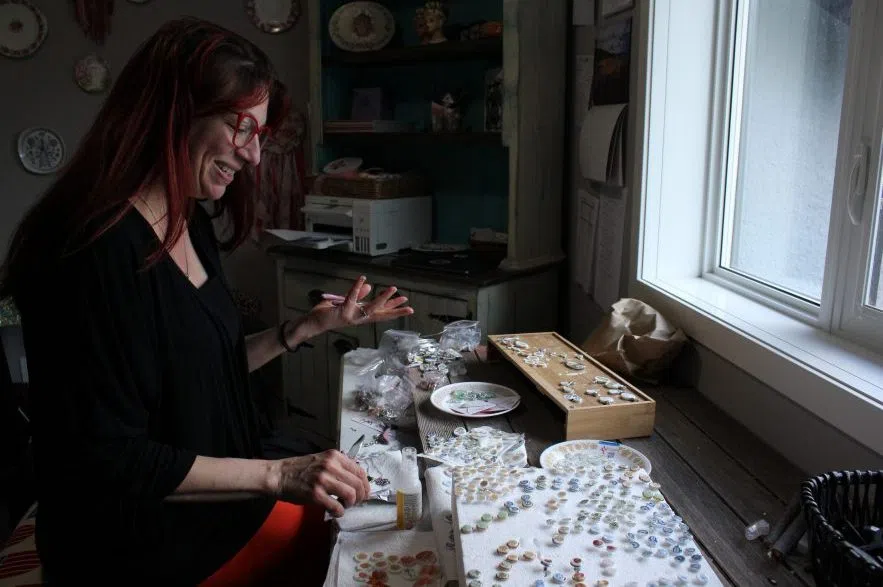
Upstairs, away from the chaos of “the pit,” Sheri Wollf brings each piece to life in a quiet, focused ritual where broken fragments of china are given a second chance at being used and valued. (Brittany Caffet/650 CKOM)
The patterns that still speak
Though she began with fine, bone china — Royal Albert, Bavarian porcelain, high tea sets — her best-selling pieces now come from more humble beginnings.
“I found some Golden Butterfly Corelle at the thrift store, and I thought, ‘You know what? I’m going to work with this, because this is what my grandma had,’” she recalled, holding a mug adorned with the familiar amber-hued pattern — its retro charm instantly recognizable to anyone who grew up in the ’80s.
“My grandmas were simple, hard-working Mennonite women. They didn’t have fancy china — they served Christmas dinner on Corelle.”
To her surprise, the tribute to her grandmothers resonated deeply with others.
“I put it up on Facebook and thought, ‘Well, nobody’s really going to like this…’ and it blew up. It became my best seller overnight.”
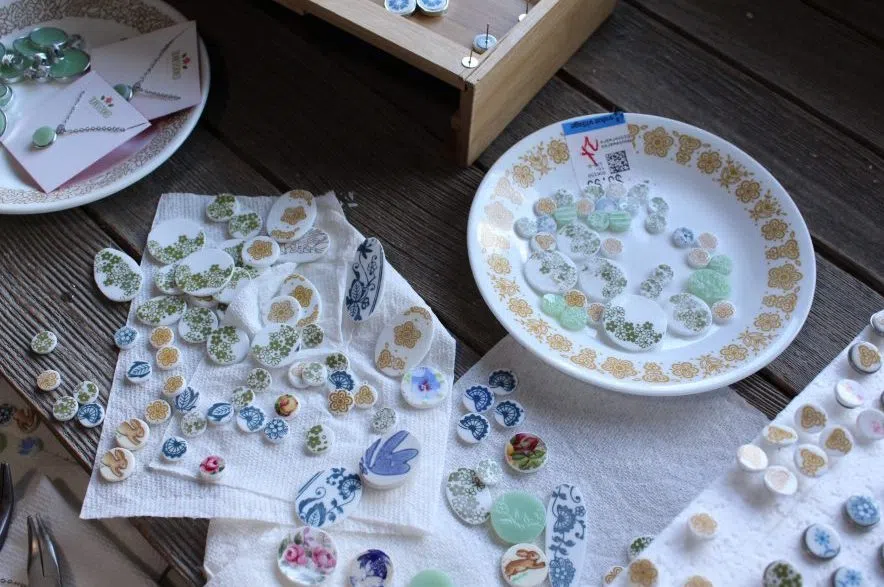
Some stories aren’t told in words — they’re passed down in porcelain and held close, long after the table’s been cleared. (Brittany Caffet/650 CKOM)
It turns out many people’s most cherished memories were not made with the delicate, gilded tea sets, but with the everyday dishes brought out during holidays, funerals, church suppers and family reunions.
“For so many of us, they’re in our memories,” Wolff explained. “The dishes were so important. They were so special. We have a huge emotional connection because it kind of brings us back to those really, really important places in our lives, with people that we really connect to.”
Wearing what they left behind
Wollf’s most meaningful work often comes in the form of custom orders, pieces created from clients’ own heirlooms, whether they’re already broken or still intact.
“I wish I would have kept track of how many orders I’ve done — it’s been hundreds and hundreds,” she said proudly.
One order she’ll never forget came from a family preparing for a grandmother’s funeral. Wollf crafted necklaces for the daughters, cuff links for the sons and ornaments for the grandchildren. And then, one very special piece was placed into the grandmother’s casket — a final, intimate tribute.
Another involved a pattern dear to many: the Corelle Spring Blossom Green pattern, also known as Crazy Daisy. When the designer of the pattern passed away, her children asked Wollf to create pieces for the entire family.
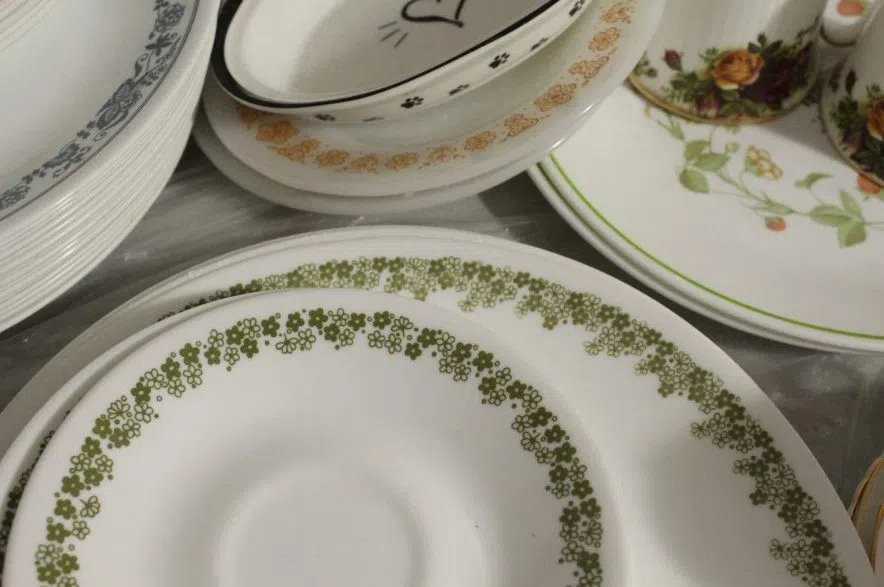
The Spring Blossom Green pattern, also known as Crazy Daisy, is one of the longest-running Corelle patterns. It was designed by artist Sarah Balbach. Her family reached out to Wollf following her passing to have keepsakes of the beloved dishes made. (Brittany Caffet/650 CKOM)
For Wanda Gatzke, Wollf’s art became a way to preserve a piece of family history before it disappeared.
“My mother-in-law had gifted me her mom and dad’s 50th wedding anniversary plate many, many, many years ago,” Gatzke explained.
“I wasn’t using it that much. It was getting a little chipped in places, and I thought ‘with my luck, I’m going to break it at some point.’ But it dawned on me, ‘you know, I have this beautiful plate, I want to do something with it.’ And so I literally handed it over to her and she made myself, my sister-in-law and each of our daughters all our own pendants with that plate.”
From a plate nearly lost to time came keepsakes crafted to last. Stories like those are why Wollf does what she does.
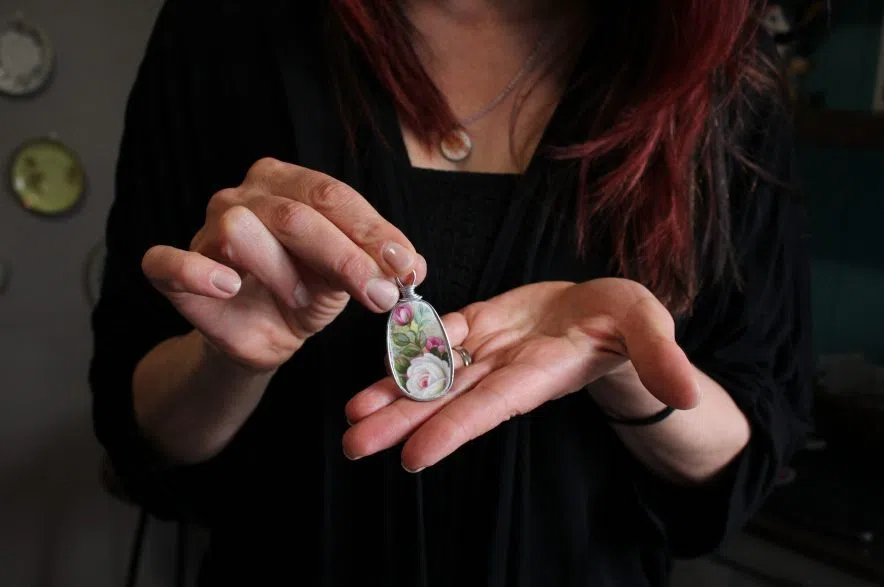
Wollf explained that these dishes were never just dishes — they were wedding gifts, or mementos of Sunday dinners and Christmases past. In every pattern, a memory lingers. (Brittany Caffet/650 CKOM)
A place for the past in the present
Wollf is, as she puts it, “a dish scavenger.” She haunts thrift stores and garage sales, and she’s developed a knack for spotting the patterns that make hearts stir.
While dishes can’t be traditionally recycled, her art gives them a second chance and gives people a new way to carry their stories forward.
“China used to be passed down from generation to generation,” she said. “But now, kids and grandkids don’t want the china. Nobody has china cabinets anymore. It just sits in boxes in the basement, collecting dust.”
But a necklace? A pair of earrings? A delicate charm from the rim of Grandma’s favorite serving platter? That’s something you can take with you.

Sheri Wollf has crafted hundreds of pieces of jewelry from once-forgotten china, now carrying family stories into the future. (Brittany Caffet/650 CKOM)
Ten years in, Wollf said she’s still captivated.
“I’m still fascinated by it,” she said.
“After 10 years, I still find it remarkable that I can take something that is ‘garbage,’ destined for the landfill, and then I can make it into something really, really pretty that people want to wear around their necks or on their fingers or on their wrists.”
At its heart, Transformed Jewelry isn’t just about repurposing dishware. It’s about preserving the memories and stories once shared over supper, and turning them into cherished keepsakes that stay with you long after the meal is over.
